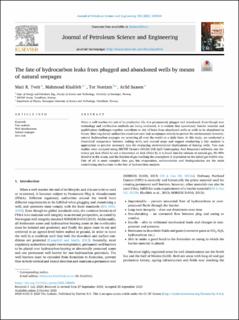| dc.contributor.author | Tveit, Mari Røstvig | |
| dc.contributor.author | Khalifeh, Mahmoud | |
| dc.contributor.author | Nordam, Tor | |
| dc.contributor.author | Saasen, Arild | |
| dc.date.accessioned | 2021-02-09T09:24:59Z | |
| dc.date.available | 2021-02-09T09:24:59Z | |
| dc.date.created | 2020-10-28T09:40:25Z | |
| dc.date.issued | 2020-10 | |
| dc.identifier.citation | Tveit, M.R., Khalifeh, M., Nordam,T. & Saasen, A. (2020) The fate of hydrocarbon leaks from plugged and abandoned wells by means of natural seepages. Journal of Petroleum Science and Engineering, 196, 108004. | en_US |
| dc.identifier.issn | 0920-4105 | |
| dc.identifier.uri | https://hdl.handle.net/11250/2726795 | |
| dc.description.abstract | When a well reaches the end of its productive life, it is permanently plugged and abandoned. Even though new technology and verification methods are being evaluated, it is evident that operational, barrier material and qualification challenges together contribute to risk of leaks from abandoned wells or wells to be abandoned in future. Most regulatory authorities constitute zero leak acceptance criteria to protect the environment; however, natural hydrocarbon seepages are occurring all over the world on a daily basis. In this study, we conducted a theoretical comparison between leaking wells and natural seeps and suggest conducting a fate analysis is appropriate to provide necessary data for evaluating environmental implications of leaking wells. Two case studies were analyzed using SINTEF Ocean's OSCAR (Oil Spill Contingency And Response) software; one historical gas leak (Field A) and a theoretical oil leak (Field B). It is found that for releases of natural gas, 95–99% dissolve in the ocean, and the fraction of gas reaching the atmosphere is dependent on the initial gas bubble size. Fate of oil is more complex than gas, but evaporation, sedimentation and biodegradation are the main contributing mechanisms in the fate of hydrocarbon analysis. | en_US |
| dc.language.iso | eng | en_US |
| dc.publisher | Elsevier Ltd. | en_US |
| dc.rights | Navngivelse 4.0 Internasjonal | * |
| dc.rights.uri | http://creativecommons.org/licenses/by/4.0/deed.no | * |
| dc.subject | petroleumsteknologi | en_US |
| dc.subject | hydrokarbonlekkasje | en_US |
| dc.title | The fate of hydrocarbon leaks from plugged and abandoned wells by means of natural seepages | en_US |
| dc.type | Peer reviewed | en_US |
| dc.type | Journal article | en_US |
| dc.description.version | publishedVersion | en_US |
| dc.rights.holder | © 2020 The Authors. | en_US |
| dc.subject.nsi | VDP::Teknologi: 500::Berg‑ og petroleumsfag: 510::Petroleumsteknologi: 512 | en_US |
| dc.source.pagenumber | 12 | en_US |
| dc.source.volume | 196 | en_US |
| dc.source.journal | Journal of Petroleum Science and Engineering | en_US |
| dc.identifier.doi | 10.1016/j.petrol.2020.108004 | |
| dc.identifier.cristin | 1842798 | |
| dc.source.articlenumber | 108004 | en_US |
| cristin.ispublished | true | |
| cristin.fulltext | original | |
| cristin.qualitycode | 2 | |

